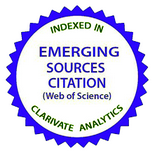Peculiarities of the Energy Transfer of Electronic Excitation in Carbazolyle-Containing Polymers
DOI:
https://doi.org/10.15407/ujpe64.5.406Keywords:
poly-N-vinylcarbazole, poly-N-epoxypropylcarbazole, fluorescence, phosphorescence, energy transfer, singlet excitons, triplet excitonsAbstract
Luminescence spectra of poly-N-vinylcarbazole (PVK), poly-N-epoxypropylcarbazole (PEPK), poly-N-vinyl-3-chlorocarbazole (Cl-PVK), and polystyrene (PS) films doped with bis[2-(2′-benzothienyl)-pyridinato-N,C3′](acetylacetonate) iridium [Btp2Ir(acac)] have been studied. The indicated carbazole-containing polymers are promising for the application in electroluminescence devices. The quantum yield of sensitized phosphorescence by Btp2Ir(acac) molecules in carbazole-containing polymer matrices is found to be lower than at their direct excitation in the PS matrix. The additional doping of the PVK-based composite with benzophenone, which transforms some of singlet excitons into triplet ones, diminishes the intensity of the sensitized phosphorescence of Btp2Ir(acac) molecules, which testifies that the efficiency of energy transfer via singlet excitons is higher than via triplet ones. The results obtained can be explained by a competition between the process of energy transfer onto the acceptor site, on the one hand, and the processes of exciton localization at the tail energy states and the trapping of triplet excitons by the products of polymer oxidation, on the other hand. The quantum yield of sensitized phosphorescence by Btp2Ir(acac) molecules in the PVK matrix is found to be almost 1.5 times lower than in the PEPK one. A conclusion is drawn that, in the PVK
matrix, the process of singlet exciton autolocalization at excimer-forming centers followed by the creation of sandwich-like excimers competes with the process of excitation energy transfer onto the acceptor.
References
J. Kido, K. Hongawa, K. Okuyama, K. Nagai. White light-emitting organic electroluminescent devices using the poly(N-vinylcarbazole) emitter layer doped with three fluorescent dyes. Appl. Phys. Lett. 64, 815 (1994). https://doi.org/10.1063/1.111023
Chang-Lyoul Lee, Kyung Bok Lee, Jang-Joo Kima. Polymer phosphorescent light-emitting devices doped with tris(2-phenylpyridine) iridium as a triplet emitter. Appl. Phys. Lett. 77, 2280 (2000). https://doi.org/10.1063/1.1315629
Weiguo Zhu, Yueqi Mo, Min Yuan, Wei Yang, Yong Cao. Highly efficient electrophosphorescent devices based on conjugated polymers doped with iridium complexes Appl. Phys. Lett. 80, 2045 (2002). https://doi.org/10.1063/1.1461418
Y. Kawamura, S. Yanagida, S.R. Forrest. Energy transfer in polymer electrophosphorescent light emitting devices with single and multiple doped luminescent layers. J. Appl. Phys. 92, 87 (2002). https://doi.org/10.1063/1.1479751
C.D. Muller, A. Falcou, N. Reckefuss et al. Multi-colour organic light-emitting displays by solution processing. Nature 421, 829 (2003). https://doi.org/10.1038/nature01390
B.C. Krummacher, Vi-En Choong, M.K. Mathai et al. Highly efficient white organic light-emitting diode. Appl. Phys. Lett. 88, 113506 (2006). https://doi.org/10.1063/1.2186080
D.-H. Lee, J.S. Choi, H. Chae et al. Highly efficient phosphorescent polymer OLEDs fabricated by screen printing. Displays 29, 436 (2008). https://doi.org/10.1016/j.displa.2008.02.006
Sung II Ahna, Wan Kyu Kim, Si Hong Ryu et al. OLED with a controlled molecular weight of the PVK (poly(9-vinylcarbazole)) formed by a reactive ink-jet process. Org. Electronics 13, 980 (2012). https://doi.org/10.1016/j.orgel.2012.02.016
Organic Light-Emitting Materials and Devices, edited by Zhigang Rick Li, Hong Meng (Taylor and Francis, 2007).
Highly Efficient OLEDs with Phosphorescent Materials, edited by H. Yersin (Wiley, 2008).
Shang-Hui Ye, Tian-Qing Hu, Zhou Zhou et al. Solution processed single-emission layer white polymer light-emitting diodes with high color quality and high performance from a poly(N-vinyl)carbazole host. Phys. Chem. Chem. Phys. 17, 8860 (2015). https://doi.org/10.1039/C4CP06063F
Yanqin Miao, Kexiang Wang, Bo Zhao al. High-efficiency/CRI/color stability warm white organic light-emitting diodes by incorporating ultrathin phosphorescence layers in a blue fluorescence layer. Nanophotonics 7, 295 (2018). https://doi.org/10.1515/nanoph-2017-0021
E. Nengquan Li, Yu Zhang, Yiwu Quan et al. High-efficiency solution-processed WOLEDs with very high color rendering index based on a macrospirocyclic oligomer matrix host. Opt. Mater. Expr. 10, 3208 (2018). https://doi.org/10.1364/OME.8.003208
K. Landfester, R. Montenegro, U. Scherf et al. Semiconducting polymer nanospheres in aqueous dispersion prepared by a miniemulsion process. Adv. Mater. 14, 651 (2002). https://doi.org/10.1002/1521-4095(20020503)14:9<651::AID-ADMA651>3.0.CO;2-V
Yu.A. Skryshevskii. Luminescence of carbazolyl-containing polymers doped with iridium chelates. Zh. Prikl. Spektrosk. 75, 323 (2008) (in Russian). https://doi.org/10.1007/s10812-008-9051-4
M. Pope, C.E. Svenberg. Electronic Processes in Organic Crystals (Oxford Univ. Press, 1982).
Y. Kawamura, K. Goushi, J. Brooks et al. 100% phosphorescence quantum efficiency of Ir(III) complexes in organic semiconductor films. Appl. Phys. Lett. 86, 071104 (2005). https://doi.org/10.1063/1.1862777
A. Itaya, K. Okamoto, S. Kusabayashi. Singlet excitation energy transfer in the vinyl polymers with pendant carbazolyl groups. Bull. Chem. Soc. Jpn. 50, 22 (1977). https://doi.org/10.1246/bcsj.50.22
S. Tagawa, M. Washio, Y. Tabata. Picosecond time-resolved fluorescence studies of poly(N-vinylcarbazole) using a pulse-radiolysis technique. Chem. Phys. Lett. 68, 276 (1979). https://doi.org/10.1016/0009-2614(79)87200-0
G. Peter, H. Bassler, W. Schrof, H. Port. Picosecond study of singlet exciton dynamics in polyvinylcarbazole (PVK) in the temperature range 5-300 K. Chem. Phys. 94, 445 (1985). https://doi.org/10.1016/0301-0104(85)80063-X
Yu.P. Piryatinskii, V.N. Yashchuk, Yu.A. Cherkasov, Yu.N. Kirpach, E.L. Aleksandrova. Luminescence of poly-N-epoxypropylcarbazole. Zh. Prikl. Spektrosk. 53, 41 (1990) (in Russian). https://doi.org/10.1007/BF00665139
Yu.A. Skryshevskii. Energy transfer by singlet and triplet excitons in carbazole-containing polymers. Zh. Prikl. Spektrosk. 79, 576 (2012) (in Russian). https://doi.org/10.1007/s10812-012-9640-0
Yu.A. Skryshevskii, O.Yu. Vakhnin. Comparisons of the efficiency of excitation energy transfer by singlet and triplet excitons in carbazolyl-containing polymers. Ukr. Fiz. Zh. 63, 24 (2018) (in Ukrainian). https://doi.org/10.15407/ujpe63.01.0025
Yu.A. Skryshevskii. Photostability of molecules of aromatic amines in a polymeric matrix. Zh. Prikl. Spektrosk. 69, 629 (2002) (in Russian). https://doi.org/10.1023/A:1021556929302
W.J. Finkenzeller, M.E. Thompson, H. Yersin. Phosphorescence dynamics and spin-lattice relaxation of the OLED emitter Ir(btp)2(acac). Chem. Phys. Lett. 444, 273 (2007). https://doi.org/10.1016/j.cplett.2007.07.022
Y. Kawamura, J. Brooks, J.J. Brown et al. Intermolecular interaction and a concentration-quenching mechanism of phosphorescent Ir(III) complexes in a solid film. Phys. Rev. Lett. 96, 017404 (2006). https://doi.org/10.1103/PhysRevLett.96.017404
I.S. Gorban, T.P. Volkova, A.Ya. Kalnitskii, V.N. Yashchuk. On the nature of structureless phosphorescence of vinyl aromatic polymers. Ukr. Fiz. Zh. 29, 1267 (1984) (in Russian).
S.P. McGlynn, T. Azumi, M. Kinoshita, Molecular Spectroscopy of the Triplet State (Prentice-Hall, 1969).
E.A. Akimova, A.V. Stronskii, A.P. Payuk et al. Record of hologram diffraction gratings on carbazole-containing thin polymer films. Optoelektron. Poluprovodn. Tekhn. 49, 31 (2014) (in Russian).
I. Glowacki, Z. Szamel, G. Wiosna-Salyga. Spectrally resolved thermoluminescence versus electroluminescence spectra of PVK doped with 1 wt% of Ir(btp)2(acac). Org. Electron. 31, 127 (2016). https://doi.org/10.1016/j.orgel.2016.01.021
H. B?assler. Exciton and charge carrier transport in random organic solids. In Disorder Effects on Relaxational Processes, edited by R. Richert, A. Blumen (Springer, 1994), p. 485. https://doi.org/10.1007/978-3-642-78576-4_18
Yu.A. Skryshevskii. Influence of macromolecule main chain structure on electron excitation energy transfer in carbazole-containing polymers. Zh. Prikl. Spektrosk. 80, 171 (2013) (in Russian). https://doi.org/10.1007/s10812-013-9740-5
Downloads
Published
How to Cite
Issue
Section
License
Copyright Agreement
License to Publish the Paper
Kyiv, Ukraine
The corresponding author and the co-authors (hereon referred to as the Author(s)) of the paper being submitted to the Ukrainian Journal of Physics (hereon referred to as the Paper) from one side and the Bogolyubov Institute for Theoretical Physics, National Academy of Sciences of Ukraine, represented by its Director (hereon referred to as the Publisher) from the other side have come to the following Agreement:
1. Subject of the Agreement.
The Author(s) grant(s) the Publisher the free non-exclusive right to use the Paper (of scientific, technical, or any other content) according to the terms and conditions defined by this Agreement.
2. The ways of using the Paper.
2.1. The Author(s) grant(s) the Publisher the right to use the Paper as follows.
2.1.1. To publish the Paper in the Ukrainian Journal of Physics (hereon referred to as the Journal) in original language and translated into English (the copy of the Paper approved by the Author(s) and the Publisher and accepted for publication is a constitutive part of this License Agreement).
2.1.2. To edit, adapt, and correct the Paper by approval of the Author(s).
2.1.3. To translate the Paper in the case when the Paper is written in a language different from that adopted in the Journal.
2.2. If the Author(s) has(ve) an intent to use the Paper in any other way, e.g., to publish the translated version of the Paper (except for the case defined by Section 2.1.3 of this Agreement), to post the full Paper or any its part on the web, to publish the Paper in any other editions, to include the Paper or any its part in other collections, anthologies, encyclopaedias, etc., the Author(s) should get a written permission from the Publisher.
3. License territory.
The Author(s) grant(s) the Publisher the right to use the Paper as regulated by sections 2.1.1–2.1.3 of this Agreement on the territory of Ukraine and to distribute the Paper as indispensable part of the Journal on the territory of Ukraine and other countries by means of subscription, sales, and free transfer to a third party.
4. Duration.
4.1. This Agreement is valid starting from the date of signature and acts for the entire period of the existence of the Journal.
5. Loyalty.
5.1. The Author(s) warrant(s) the Publisher that:
– he/she is the true author (co-author) of the Paper;
– copyright on the Paper was not transferred to any other party;
– the Paper has never been published before and will not be published in any other media before it is published by the Publisher (see also section 2.2);
– the Author(s) do(es) not violate any intellectual property right of other parties. If the Paper includes some materials of other parties, except for citations whose length is regulated by the scientific, informational, or critical character of the Paper, the use of such materials is in compliance with the regulations of the international law and the law of Ukraine.
6. Requisites and signatures of the Parties.
Publisher: Bogolyubov Institute for Theoretical Physics, National Academy of Sciences of Ukraine.
Address: Ukraine, Kyiv, Metrolohichna Str. 14-b.
Author: Electronic signature on behalf and with endorsement of all co-authors.

















